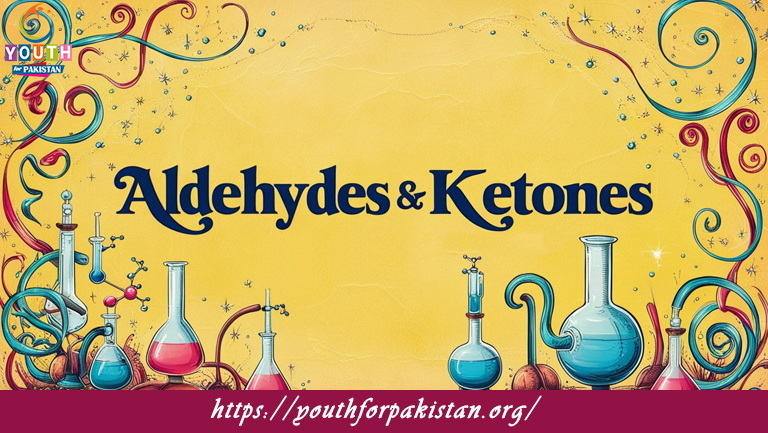Welcome to the Aldehydes & Ketones Reactions MDCAT MCQs with Answers. In this post, we have shared Aldehydes & Ketones Reactions Multiple Choice Questions and Answers for PMC MDCAT 2024. Each question in MDCAT Chemistry offers a chance to enhance your knowledge regarding Aldehydes & Ketones Reactions MCQs in this MDCAT Online Test.
The reaction of aldehydes with Tollens’ reagent produces:
a) Alcohol
b) Carboxylic acid
c) Silver mirror
d) Ketone
The reagent used in the reduction of aldehydes to primary alcohols is:
a) NaBH₄
b) KMnO₄
c) H₂SO₄
d) Br₂
Ketones react with iodine in the presence of a base to form:
a) Iodoform
b) Ester
c) Alcohol
d) Aldehyde
The reaction of aldehydes with Fehling’s solution yields:
a) No reaction
b) Red precipitate
c) Blue solution
d) Yellow precipitate
In the reaction of aldehydes with HCN, the product formed is:
a) Cyanohydrin
b) Carboxylic acid
c) Ester
d) Ketone
The reaction of ketones with Grignard reagents produces:
a) Aldehydes
b) Tertiary alcohols
c) Esters
d) Carboxylic acids
The test for aldehydes using Schiff’s reagent gives a:
a) Pink color
b) Blue color
c) Green color
d) Yellow color
The reaction of aldehydes with sodium bisulphite forms:
a) Aldehyde bisulphite
b) Sodium salt
c) Ketone
d) Alcohol
The oxidation of a ketone generally results in:
a) Carboxylic acid
b) Aldehyde
c) No reaction
d) Ester
Aldehydes can be oxidized to carboxylic acids using:
a) Tollens’ reagent
b) Fehling’s solution
c) KMnO₄
d) NaBH₄
The reaction of ketones with a primary amine yields:
a) Ketone
b) Imine
c) Amide
d) Alcohol
The reaction of aldehydes with acetic anhydride in the presence of an acid catalyst forms:
a) Ester
b) Aldehyde
c) Ketone
d) Carboxylic acid
The product of the reaction between a ketone and phenylhydrazine is:
a) Hydrazone
b) Alcohol
c) Ester
d) Aldehyde
Aldehydes can be reduced to primary alcohols using:
a) LiAlH₄
b) NaOH
c) KMnO₄
d) HNO₃
The reaction of aldehydes with NaOH followed by acidification produces:
a) Aldol
b) Ester
c) Carboxylic acid
d) Alcohol
The reaction of ketones with nitrous acid forms:
a) Nitroso compound
b) Ester
c) Alcohol
d) Aldehyde
The reagent used to distinguish between aldehydes and ketones is:
a) Tollens’ reagent
b) NaBH₄
c) HCN
d) Schiff’s reagent
The reaction of aldehydes with excess alcohol and an acid catalyst results in:
a) Acetal
b) Ester
c) Ketone
d) Carboxylic acid
The reaction of aldehydes with sodium hydroxide and iodine is known as:
a) Iodoform test
b) Tollens’ test
c) Fehling’s test
d) Schiff’s test
Ketones react with which of the following to form 2,4-dinitrophenylhydrazones?
a) Phenylhydrazine
b) Sodium bisulphite
c) Sodium hydroxide
d) Acetic acid
Aldehydes can be identified using the:
a) Benedict’s solution
b) Tollens’ reagent
c) Br₂ in water
d) Fehling’s solution
The reaction of ketones with hydrochloric acid in the presence of zinc dust produces:
a) Aldehyde
b) Carboxylic acid
c) Alcohol
d) Ester
Which of the following reactions involves the formation of a carbinolamine?
a) Reaction with primary amine
b) Reaction with NaBH₄
c) Reaction with HCN
d) Reaction with phenylhydrazine
The reaction of aldehydes with alcohols and an acid catalyst forms:
a) Acetal
b) Ketone
c) Carboxylic acid
d) Ester
The product formed by the oxidation of a primary alcohol to an aldehyde is:
a) Aldehyde
b) Ketone
c) Ester
d) Carboxylic acid
The reaction of ketones with sodium bisulphite forms:
a) Bisulphite addition compound
b) Aldehyde
c) Carboxylic acid
d) Ester
The reagent used to perform the iodoform test on ketones is:
a) Iodine and NaOH
b) Tollens’ reagent
c) Fehling’s solution
d) Schiff’s reagent
The product of the reaction between a ketone and a Grignard reagent is:
a) Tertiary alcohol
b) Aldehyde
c) Ester
d) Carboxylic acid
Aldehydes react with which of the following to form a diol?
a) KMnO₄
b) HCN
c) NaBH₄
d) Fehling’s solution
The reaction of aldehydes with hydrogen peroxide in the presence of an acid catalyst results in:
a) Hydrate formation
b) Ester formation
c) Ketone formation
d) Aldol condensation
The reaction of ketones with hydrogen cyanide forms:
a) Cyanohydrin
b) Aldehyde
c) Alcohol
d) Ester
The reagent used in the reduction of ketones to secondary alcohols is:
a) LiAlH₄
b) NaOH
c) KMnO₄
d) HNO₃
The product formed from the reaction of aldehydes with phenylhydrazine is called:
a) Phenylhydrazone
b) Acetal
c) Carboxylic acid
d) Ester
The oxidation of a ketone with mild oxidizing agents results in:
a) No reaction
b) Aldehyde
c) Carboxylic acid
d) Ester
The reaction of aldehydes with acid chlorides and an acid catalyst produces:
a) Anhydrides
b) Carboxylic acids
c) Esters
d) Acetals
The product formed when a ketone reacts with a secondary amine is:
a) Imine
b) Aldehyde
c) Carboxylic acid
d) Ester
The reagent used to detect aldehydes via a redox reaction is:
a) Fehling’s solution
b) NaBH₄
c) HCN
d) NaOH
In the aldol condensation reaction, the aldehyde reacts with:
a) Another aldehyde or ketone
b) Sodium hydroxide
c) Hydrochloric acid
d) Sodium chloride
The reaction of aldehydes with alcohols in the presence of an acid forms:
a) Acetals
b) Ketones
c) Carboxylic acids
d) Esters
The product of the oxidation of an aldehyde is:
a) Carboxylic acid
b) Ketone
c) Alcohol
d) Ester
If you are interested to enhance your knowledge regarding Physics, Chemistry, Computer, and Biology please click on the link of each category, you will be redirected to dedicated website for each category.








